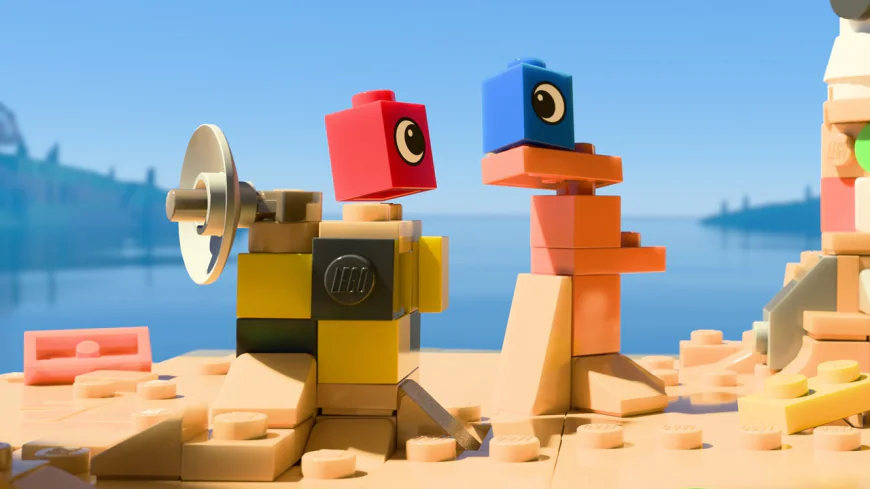LEGO Voyagers Might Already Be My Favorite LEGO Game Ever


My 14-year-old daughter and I have played through all of Hazelight’s games in recent months. We thoroughly enjoyed It Takes Two, had a blast with A Way Out, and were absolutely smitten with Split Fiction. I’m just so thrilled that Hazelight has almost single-handedly turned the “mandatory-two-player co-op” subgenre into a viable segment of the gaming market. I previewed Out of Words last month, and that one is definitely going to be on my daughter and I’s must-play list for next year. But in the meantime – in less than a month from now, in fact – we’ve got LEGO Voyagers to look forward to. As soon as I saw the reveal trailer for it back in June, I was instantly drawn to it. And now that my daughter and I have played the first 30 minutes of it, we absolutely can’t wait to play the rest.
Co-op is nothing new to LEGO games, certainly, but the bulk of them – developed by Traveler’s Tales – have been smartly designed single-player action-adventures with optional co-op that expertly weave in a big license like Star Wars or Indiana Jones, using humor to put a slight twist on the license’s usual vibe. LEGO Voyagers, crafted by LEGO Builder’s Journey developer Light Brick, removes the “optional” from the co-op, and strips any big-IP license away as well. We’re left with a game that combines puzzles and platforming and puts it in a compelling co-op package. Oh, and there isn’t a single line of dialogue. See, you each play as a small, simple 1x1 LEGO brick that has a blinking eye on one side. Pressing X on the Xbox controller (we played on PC, though LEGO Voyagers is coming to every console as well) makes your brick “sing.” That’s the developer’s term, not mine, and I point that out because they don’t literally sing. Instead, they make a nonverbal sound that creative director Karsten Lund tells me can change depending on the context of the situation. (Oh, and by the way: I asked and Lund said the two brick characters don’t have formal names; internally they just call them Red and Blue.) The singing is also used to get your co-op partner’s attention if you’re playing online without microphones. I played the demo twice: once in local same-screen co-op with my daughter, and a second time online with Lund using Discord voice chat. And as a quick but relevant aside while talking about online play: like Hazelight’s games, LEGO Voyagers will include a Friend Pass so that you’re able to play online with a friend with only one of you owning the game.
Besides singing, you can roll around, jump, snap to an attachable piece, and rotate when attached to a piece. That’s the extent of your controls, and you’ll literally roll through the story (though for the record, the developers call it “tumbling”), building together to solve platforming puzzles and taking frequent pitstops along the way to play on something. In the early going, for instance, you’ll encounter a little beach area filled with LEGO versions of crabs – flat 1x2 pieces with C-shaped “claws.” And yes, you can snap onto them and stack them onto other crabs. Does it serve any gameplay or story purpose? No. Is it fun? Absolutely.
And that seems to be precisely the point. Lund told me that LEGO Voyagers has three pillars: puzzle-platforming, friendship, and co-op. There does appear to be some kind of story, though, as right from the get-go you’ll witness a rocket launch that goes awry, scattering pieces of the crashed ship you’ll follow the trail of. Will LEGO Voyagers have some poignant moment waiting for players near the end like fellow dialogue-free physics puzzle platformers Limbo and Inside? That remains to be seen, but even if it doesn’t, it’s clear that Voyagers intends to make its memories along the journey if not the destination. But hopefully it’ll do so in both.
Things start very, very simply in the beginning, of course, with the easiest of brick-stacking puzzles that lead you to the next area up above. You’ll collect loose pieces from nearby and work together to form bridges that span non-jumpable gaps, and later fling bricks across a river to weigh down a drawbridge of sorts low enough to let the player on the near side of the waterway hop on and safely cross.
It should be noted that “death” isn’t the slightest bit penalized in LEGO Voyagers. You can and will roll off the edge of the play area frequently, but you’re instantly respawned in the same place you fell off. And speaking more generally about difficulty, I asked Lund about it. Because after I completed the demo with my daughter – while recognizing that it was seemingly the very beginning of the game – my only real concern about Voyagers is that, given its playful, all-ages approachability, it might not offer any real challenge whatsoever to seasoned gamers, even near the end of the campaign. And Lund didn’t exactly shoot down my suspicion, telling me, “We've tried to make a very balanced experience. The Light Brick way of doing things is to make sure everybody gets through [the game]. But there are puzzles that really make you think outside the box. It does ramp up a little bit, but there are no huge [difficulty] spikes. It's about experiencing this whole narrative and trying to have fun together.”
On that note, sometimes you literally work together, combining Red and Blue along with other pieces in the environment, at which point you both control the ensuing mass of LEGO plastic at the same time. This necessitates coordination and cooperation, like when we stacked a bunch of plums to ourselves – after we shook them out of a nearby tree – so that we could get tall enough to vault ourselves up onto a higher platform. I really do hope this gets bigger and more complicated as the campaign goes along, because my daughter and I had some good laughs trying to get on the same page while moving our combined plastic monstrosity.
Lund also told me that you could build every setpiece in the game in real life with actual LEGO bricks; they are not cheating in the level design on the development side. Every piece of geometry is a LEGO piece, which is only enhanced by the clean, fairly realistic graphics that more or less simulate the environments being real-world LEGO sets. I love the tiny LEGO birds that fly through parts of the levels, the gentle currents of water burbling over the plastic pieces, and the soft lighting that casts appropriate shadows on other bricks.
I should also take a moment to shout out the music. This is a very chill, very playful game, and the soundtrack – based on what I’ve heard so far – complements that really nicely. It’s very mellow and intentionally low-key; it has yet to leap to the foreground and instead serves as a relaxing companion to the playfulness happening on screen.
With no disrespect to the many other fantastic LEGO games, I adore the spirit and two-player cooperation of LEGO Voyagers so much that I think it might become my favorite LEGO game ever once my daughter and I get to play the rest of it on September 15.
What's Your Reaction?
 Like
0
Like
0
 Dislike
0
Dislike
0
 Love
0
Love
0
 Funny
0
Funny
0
 Angry
0
Angry
0
 Sad
0
Sad
0
 Wow
0
Wow
0









































